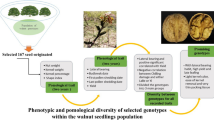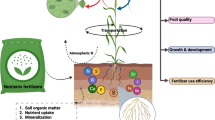Abstract
In the present work, three promising ginger cultivars, Suprabha, Suravi and Varada, were cultivated in nine agro-climatic regions of Odisha to find the best performing variety in terms of high yield of rhizome, essential oil and oleoresin with low fibre content. A range of variation in essential oil (1–3.2%), oleoresin (4.2–10.5%), crude fibre (5.0–11.0%) and rhizome (109–293 g/plant) yield was observed across different regions. An analysis of variance (ANOVA) and post hoc Tukey’s test showed a significant differentiation among three cultivars of ginger in quantitative morphological traits and phytochemicals assessed. Even correlation studies showed a descending order of association of plant height with rhizome yield (r = 0.91), tiller number (r = 0.77), essential oil (r = 0.56) and oleoresin (r = 0.47) content facilitates as an aid to selection of superior promising genotype. From the outcome of multi-location trials, cultivar Suravi can be recommended for North Eastern Ghat, Eastern Ghat High Land, and South Eastern Ghat regions. Cultivar Varada can be suggested for North Western Plateau and North Central Plateau Eastern Ghat High Land regions. Cultivar Suprabha for North Eastern Coastal Plain, East and South Eastern Coastal Plain, Western Central Table Land and Mid Central Table Land regions as they performed best in these regions for the targeted yield parameters.



Similar content being viewed by others
References
Factfish (2016) India: Ginger, production quantity (tons). http://www.factfish.com/statistic-country/india/ginger,productionquantity. Accessed 8 July 2016
Liu Y, Whelan R, Pattnaik B, Ludwig K, Subudhi E, Rowland H, Claussen N, Zucker N, Uppal S, Kushner D, Felder M, Patankar M, Kapur A (2012) Terpenoids from Zingiber officinale (Ginger) induce apoptosis in endometrial cancer cells through the activation of p53. PLoS ONE 7:e53178
Ravindran PN, Nirmal Babu KN (2005) Introduction In: Ravindran, P.N., Nirmal, B.K. (Eds.), Ginger: The genus Zingiber, pp 15–85
Morison JIL, Lawlor DW (1999) Interactions between increasing CO2 concentration and temperature on plant growth. Plant Cell Environ 22:659–682
Zhang XD, Yu YG, Yang DF, Qi ZC, Liu RZ, Deng FT, Cai ZX, Li Y, Sun YF, Liang ZS (2018) Chemotaxonomic variation in secondary metabolites contents and their correlation between environmental factors in Salvia miltiorrhiza Bunge from natural habitat of China. Ind Crops Prod 113:335–347
Ramakrishna A, Ravishankar GA (2011) Influence of abiotic stress signals on secondary metabolites in plants. Plant Signal Behav 6:1720–1731
Gutbrodt B, Dorn S, Unsicker SB, Mody K (2012) Species-specific responses of herbivores to within-plant and environmentally mediated between-plant variability in plant chemistry. Chemoecol 22:101–111
Govindarajan VS (1982) Ginger chemistry, technology and quality evaluation. Crit Rev Food Sci Nutr 17:1–258
Das A, Kar C, Subudhi E (2014) Diversity of exportable phytochemical traits in ginger from 10 agro-climatic zones of Odisha. J Chem Pharm Sci, pp 16–22
Sandeep IS, Kuanar A, Akbar A, Kar B, Das S, Mishrab A, Sial P, Naik PK, Nayak S, Mohanty S (2016) Agro climatic zone based metabolic profiling of turmeric (Curcuma longa L.) for phytochemical yield optimization. Ind Crop Prod 85:229–240
Malosetti JM, Van Eeuwijk FAM (2013) The statistical analysis of multi-environment data: modelling genotype-by-environment interaction and its genetic basis. Front Physiol 4:1–17
Parthasarathy VA, Srinivasan V, Nair RR, John Zachariah T, Kumar A, Prasath D (2012) Ginger: botany and horticulture. Horti Revi 39
Babu MS, Kumar BP, Swami DV, Krishna KU, Emmanuel N (2017) Performance of ginger (Zingiber officinale Rosc.) varieties under shade net condition of costal Andhra Pradesh. Int J Curr Microbiol App Sci 6:494–498
Jayashree E, Visvanathan R, John Zachariah T (2014) Quality of dry ginger (Zingiber officinale) by different drying methods. J Food Sci Technol 51:3190–3198
Guenther E (1972) The production of essential oils. Methods of distillation, enfleurage, maceration, and extraction with volatile solvents, the essentials oils 1. History, production and analysis. Krieger publishing company, Malabar
ASTA (1978) Official analytical methods of the American Spice Trade Association, pp 38–41
Maynard AJ (1970) Methods in food analysis. Academic press, New York, p 176
Best DJ, Roberts DE (1975) Algorithm AS 89: The Upper Tail Probabilities of Spearman’s rho. J App Stat 24:377–379
Rajyalakshmi R, Umajyothi K (2014) Evaluation of ginger (Zingiber officinale Rosc.) varieties in high altitude and tribal zone of Srikakulam district of Andhra Pradesh. J Spices Aromat Crop 23:258–261
IISR (1995) Indian Institute of Spices Research. Ann Rep 1994–95
Chaudhary AS, Sachan SK, Singh RL (2006) Studies on varietal performance of turmeric (Curcuma longa L.). Indian J Crop Sci 1:189–190
Gaur M, Das A, Sahoo RK, Mohanty S, Joshi RK, Subudhi E (2016) Comparative transcriptome analysis of ginger variety Suprabha from two different agro-climatic zones of Odisha. Genomics Data 9:42–43
Pandotra P, Gupta AP, Husain MK, Gandhiram GS (2013) Evaluation of genetic diversity and chemical profile of ginger cultivars in northwestern Himalayas. Biochem Syst Ecol 48:281–287
Ravi Kiran C, Chakka AK, Padmakumari Amma KP, Nirmala Menon A, Sree Kumar MM, Venugopalan VV (2013) Essential oil composition of fresh ginger cultivars from North-East India. J Essent Oil Res 25:380–387
Chongtham T, Chatterjee R, Hnamte V, Chattopadhyay PK, Khan SA (2013) Ginger germplasm evaluation for yield and quality in Southern West Bengal. J Spices Arom Crops 22:88–90
Kale UB, Hegde NK, Hanamashetti SI, Patil PL (2003) Quality of ginger genotypes in the Ghataprabha left bank command area of Northern Karnataka. J Agric Sci 16:633–635
Goudar SA, Hussain MDS, Dodamani SM, Mahantesh PS, Pujarii R (2017) Evaluation of ginger (Zingiber officinale Rosc.) genotypes for quality attributes. Int J Pure App Biosci 5:32–836
Sanwal SK, Singh SK, Yadav RK, Singh PK, Misra AK (2012) Yield and quality assessment of ginger (Zingiber officinale Rosc.) genotypes. Indian J Pl Gen Res 25:281–286
Kumar A, Kapoor C, Rahman H, Karuppaiyan R, Rai S (2016) Multivariate analysis of ginger (Zingiber officinale Rosc.) germplasm of North Eastern India. Indian J Genet Plant Breed 76:221–223
Nandkangre H, Ouedraogo M, Sawadogo M, Bado S, Sawadogo N, Ouoba A, Konate MN (2016) Morphometric and agronomic characterization of 56 ginger landraces in Burkina Faso. J Appl Biosci 100:9545–9556
Acknowledgements
This work was financially supported by the Department of Science and Technology, New Delhi (Grant Number SERB/SR/SO/PS/41/2012). We are also thankful to our President, Prof. M.R. Nayak and Dean, Prof. S.C. Si, Centre of Biotechnology, Siksha ‘O’ Anusandhan (Deemed to be University), Bhubaneswar, for providing infrastructure and encouragement. We even owe thanks to Mr P. Sial, In-charge HARS, Pottangi, and Mr. A. Mishra OUAT, Bhubaneswar, for supplying the released ginger cultivars and helping us to plant and record the data at different climatic regions.
Author information
Authors and Affiliations
Corresponding author
Ethics declarations
Conflict of interest
The authors declare that they have no conflict of interest.
Additional information
Publisher's Note
Springer Nature remains neutral with regard to jurisdictional claims in published maps and institutional affiliations.
Significance Statement
The selection of elite ginger is based on an established statistical correlation between the marketable traits; high essential oil, oleoresin, and low fibre with rhizome yield. Agro-climate-zone-specific cultivars are identified by cultivating; Suruchi, Suprabha and Varada genotype among nine zones of the state. This will benefit the state and country's large-scale secondary metabolite production.
Supplementary Information
Below is the link to the electronic supplementary material.
Rights and permissions
About this article
Cite this article
Das, A., Behera, D.U., Sahoo, R.K. et al. Phytochemical and Morphological Traits of Ginger Cultivars are Modulated by Agro-Climatic Conditions. Proc. Natl. Acad. Sci., India, Sect. B Biol. Sci. 92, 783–790 (2022). https://doi.org/10.1007/s40011-022-01361-3
Received:
Revised:
Accepted:
Published:
Issue Date:
DOI: https://doi.org/10.1007/s40011-022-01361-3




